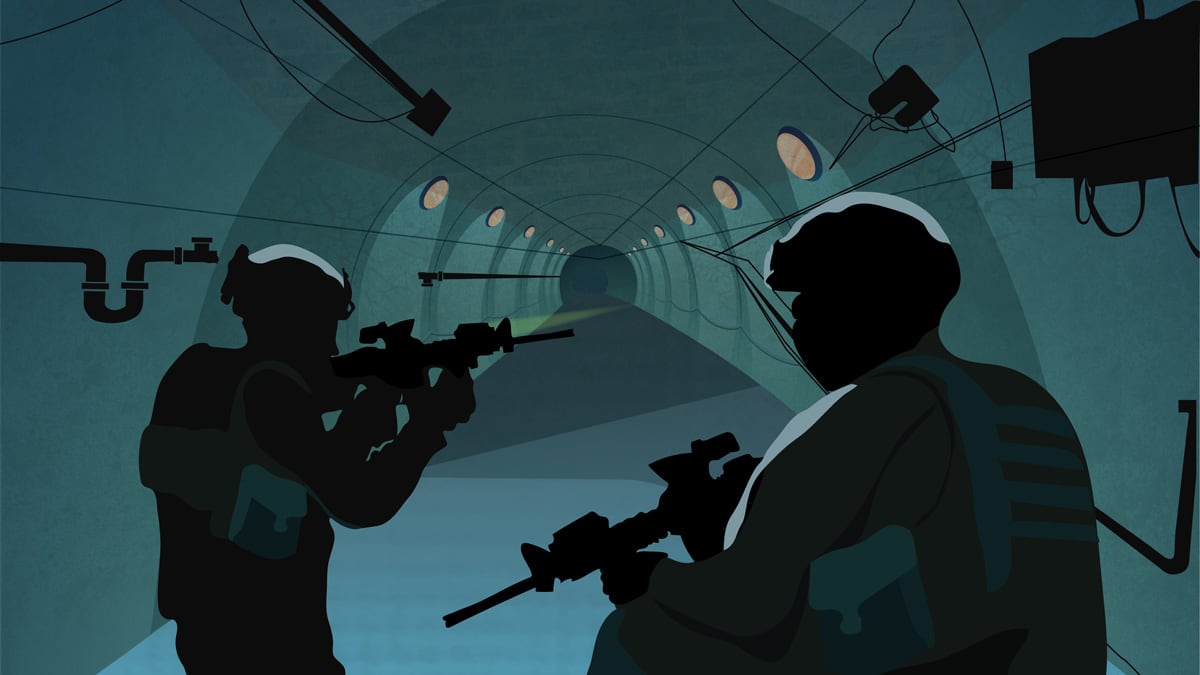Marines are headed to the state of Indiana in August as part of a restart of the Corps’ long-running interest in urban warfare.
A rifle company worth of grunts will prowl the mock-city terrain of the Muscatatuck Urban Training Center in Butlerville, Indiana, while testing out a new formation, new positions and new technology the Corps is asking to bring to the fight.
This coming rotation will be the first held each August until 2023, according to a recent online posting by the Marine Corps Warfighting Lab.
The focus areas for this year’s experiments include sensing and locating threat, lethality, command and control and maneuver.
What that will look like to the Marines patrolling urban areas includes mass and precision fire solutions that can penetrate buildings, walls and other structures with or without destroying them. Grunts will try out fire-and-forget weapons systems that can be used in close quarters without backblast or overpressure problems inherent in many current options.
Some of those weapons will arm and destroy in ranges as short as 20 meters.
RELATED

They’ll also look at indirect fires that can be used in short ranges but without the serious collateral damage that even modern weaponry still has problems avoiding.
But evaluations go beyond blowing up stuff and shooting bad guys. They’ll also look to ways to cover their electronic signature, a key in any modern battlefield, and ways to sense their targets to distinguish between enemies, civilians and friendly forces.
A big way to achieve that will be sharing information, which is why they’re looking at ways to share common operating picture across various platforms from the individual soldier down in a tunnel to the commanders above ground nearby, back at a command post or even continents away.
For nearly three years in the early 2000s, top thinkers in the Marine Corps Warfighting Lab and elsewhere looked at how to update decades-old tactics, techniques, procedures, organization and equipment for the modern battlefield.
From that effort emerged early drone, microrobot and communications experiments, rigid foams to seal rooms in house clearing and nonlethal options for bypassing sniper.
Metropolis I also gave the next generation of Marines new ways to fight through training changes to attacks, defense, patrolling, sustainability, marksmanship, squad and platoon-level combined arms and intrasquad radio abilities in the urban environment.
This newly relaunched effort aims to look at current tech and more than 15 years of real-world battle experience and apply it to tomorrow’s urban problems.
The day-to-day for the Marines on the ground will consist of basic urban training skills followed by evaluation vignettes and then force on force training, Maj. Edward Leslie, lead planner for Dense Urban Operations, Experiment Division at MCWL, wrote in an email.
While some Marines will have had urban experience on deployment or in training, others will be entering the environment for the first time.
At the same time, Leslie wrote, they’ll also be evaluating potentially brand new equipment, learning how it works and how to employ it as they train.
“We want the Marines comfortable with the equipment when they begin the vignettes,” Leslie wrote. “We know they will just revert back to the old, familiar equipment if they don't have the familiarity with new equipment that is required to be built in the (Basic Urban Skills Training) phase.”
Some of that equipment will include new or different communications gear, ground robots and vehicles, drones and assorted sensors, he wrote.
Also, mortar, machine gun and engineer squads will have tech specific to their jobs.
During the evaluation section, the observers will look at how the new equipment is being used compared to current equipment.
“We want to identify which equipment is preferred, what the gaps are, and creative employment techniques that the Marines will surely come up with,” Leslie wrote. “We will do this with a mix of scenarios, some using current capabilities to establish a baseline and others having the new equipment incorporated.”
They’ll add new equipment on different objectives to get a solid sample.
Training will run in day and night scenarios, some for multiple days, he wrote.
“The force on force will be the culminating event as the rifle company operates over four days against the threat force in a realistic environment that replicates an urban conflict within the context of Expeditionary Advanced Base Operations,” Leslie wrote.
Those same opponents will carry tech equal to or better than the Marines in the blue force, that way evaluators can see how it performs against a near-peer or peer competitor.
Situational awareness work will include a lot of efforts but the thrust of the upcoming experiments is through improved sensing and communications gear, Leslie wrote.
To avoid or reduce fratricide, better drones, optics, robots, vehicles and other sensors are being employed in this first round of experimentation.
But sometimes, it’s the speed and accuracy of information that can matter most. The quantity has its own quality and difficulty.
“The amount of information available to decision-makers can at times be at a level that cripples decision making or adds unnecessary friction through decision-making intermediaries,” Leslie said. “This experiment seeks to answer how information is processed throughout the company, what information is necessary at what level, how it is shared amongst squads, and what level is appropriate for specific authorizations for munitions employment.”
For example, he wrote, modern tech can allow individual-level Marines to mark up their territory with a host of symbols and tracking items that can quickly crowd a tablet and overwhelm what’s needed most from the intelligence at the right time.
“We want to find that sweet spot of knowing what is good to have and what is required to make decisions effectively,” Leslie wrote. “Additionally, with Heads Up Displays soon being available to close combat Marines, we need to assess and develop the best techniques to employ them so that when they are fielded, the Marines do not become frustrated with them or not use them to their fullest potential.”
The experiments are seeking to “expand the scope and depth of lethal engagement options available to the small units” in urban terrain.
Leslie offered an example of what they’re considering through the work of Metropolis II.
A Marine can use a drone or ground sensors to alert a squad leader on one side of a building about an enemy on the other side but can’t engage with weapons at hand.
In that case, the squad leader could use loitering munitions called up by the squad systems operator ― a new position added in the recent changes to squad formations.
"That information can be shared to adjacent squads so they now are aware of an enemy threat they could not see, which may leave open up options for how to best deal with the situation,” Leslie wrote.
And lastly, underground.
An initiative also seeks to deal with the host of subterranean spaces in urban terrain.
“Marines can also use these to their advantage to exploit ‘hollow space’ to maneuver within an urban environment undetected,” Leslie wrote. “Some of these passages can be very dangerous even without an enemy opposing them, and it is clear that subterranean spaces will require specialized training and equipment in how to survive, navigate, and communicate.”
To hit that objective, they’re seeking equipment, techniques and procedures for future experiments in urban underground space. Some will likely include mapping ground robots, he wrote.
Todd South has written about crime, courts, government and the military for multiple publications since 2004 and was named a 2014 Pulitzer finalist for a co-written project on witness intimidation. Todd is a Marine veteran of the Iraq War.



